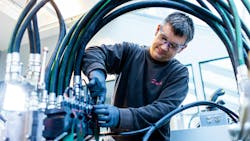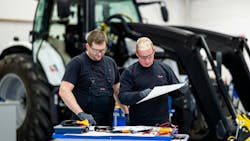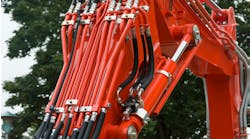Danfoss Sees Growth Opportunities Despite Down Cycle
The fluid power sector and many of its customer markets have had a more difficult year in 2024 due to many economic factors, including high interest rates. This has led to reduced demand for machines of various types and thus lower demand for the hydraulic and pneumatic systems utilized within them.
While the current down cycle has presented challenges, Eric Alström, President of Danfoss Power Solutions, also sees many opportunity areas for hydraulics — a technology which he said the company remains bullish on.
Power & Motion spoke with Alström about the challenges and opportunities faced in 2024 as well as what may be in store for the company and broader hydraulics industry in 2025.
Editor’s Note: Questions and responses have been edited for clarity. Read "Danfoss Optimistic About the Future of Hydraulics" for the second part of our interview with Alström in which he discusses the continued potential for hydraulics.
Power & Motion (P&M): How has 2024 been for Danfoss Power Solutions and the hydraulics industry in general?
Eric Alström (EA): Much tougher than expected. We were thinking it was going to be a challenging year; one year ago, when we spoke to customers and tried to assess what the market would look like, we figured it would be a flat market in 2024 over 2023 but it’s down quite a bit for many of our partners, for many of the OEMs. Many of our customers have been shedding employees and cutting out entire shifts and taking down weeks with very short notice, so it’s been a very difficult year.
We [were] prepared for the down cycle because it’s a very cyclical industry, but the severity and length of this down cycle took us a little bit by surprise. Normally, [within] 15 months…demand should start to build up again, but we don’t really see that at the moment [except] in a few areas. In general, it’s looking like a very tough year.
P&M: Are there any factors Danfoss has noticed that are impacting the hydraulics industry or is it just the general global economy and higher interest rates?
EA: All of the above I would say. You have the geopolitical tension and war in the Middle East, war in Ukraine, tension with Asia, and so that is certainly not helping. But I think the real root cause or issue is the high interest rates because a lot of the end users for our customers’ machines are financing their machine. They’re leasing their machines and of course, leasing rates are super high or at least comparably, and those that buy machines are also holding off because of [interest rates].
Crop prices haven’t been helping us either because they have been low or wildly fluctuating which means that farmers are also hesitant to invest in new equipment, regardless if they lease or buy. All of these factors are harming us. Now, there’s talk from the Fed (U.S. Federal Reserve) and the ECB (European Central Bank) in Europe to lower interest rates and I think that would be a welcome move for all of us in our industry.
Editor’s Note: This interview was conducted September 10 prior to the U.S. Federal Reserve announcing its first interest rate cut in 4 years on September 18. Read “A Manufacturer's Guide to Interest Rate Cuts” from IndustryWeek, an Endeavor Business Media partner site, to learn more about the cut and its potential impact on the manufacturing sector.
P&M: We’ve heard the same thing, once interest rates start to lower, that might help.
EA: It will to some extent. There is also an element of high inventory in the supply chain, from finished machinery standing in dealer lots to our partners having higher inventory than normal, also driven by the fact that there’s been lower demand. That inventory needs to be built back down, so that would also perhaps extend things [the current down cycle] a little bit.
P&M: You mentioned earlier that Danfoss was preparing for the downturn. Could you talk about how the company did so?
EA: We pride ourselves on being able to flex fairly well; flexing cost [and] also flexing capacity. And that means that we're well prepared when there is a downturn. Now, like I said, this one is a little bit more pronounced and a little bit longer than expected, but we're also well prepared for when the cycle picks back up again, because it's just as important to be able to flex back up again, and in the past, we've been really good at managing both, and I still think we are.
P&M: What have been some of the opportunity areas Danfoss has seen despite the downturn?
EA: There are opportunities out there, and I do have a sense that with our partners and our great sales people we are out there taking market share in an industry that looks like this. But of course, there are also hotspots out there. If you think about electrification, there’s a fair amount of investment in electrification. It used to be more image products that were engineered, now it’s real electric solutions that are being sold, so it is meaningful revenue coming [in] for our partners and for us in that space.
We also see fluid conveyance [as an opportunity area] because it is one of those products that is a little bit counter cyclical sometimes. During a down cycle, people tend to refurbish and extend machinery a little longer, [leading] to higher demand for hoses, for instance.
We’ve seen strength in the industrial channel. That is the division in Danfoss Power Solutions that is doing the best at the moment. In some markets we actually see growth in industrial products; the only country I’d say that is going well still is India. We have very strong demand in India.
P&M: Is that because there is a lot of investment in manufacturing or are there other industrial segments driving that demand?
EA: In India it is across the board because there is a lot of government funded construction projects — railroads, ring roads around cities and so on. That’s helping, just like here in the U.S. with the infrastructure package that is really making a difference. But that’s of course mainly large road building equipment such as pavers, rollers and things like that. So not the smaller equipment. That is a good sign of when the industry picks up, or the general economy picks up in the U.S.; housing starts and construction projects to a smaller scale are picking back up and that is usually a strong sign that things are becoming better. Large road building equipment is still doing well and that’s why some of the OEMs are less impacted if they sell products into that space.
Watch Power & Motion's interview with Alström below to learn more about the opportunities for hydraulics provided by the U.S. Infrastructure Bill.
P&M: How is Danfoss feeling about 2025 and beyond? We’ve heard things are supposed to start picking up at the end of this year and early next year.
EA: I'm not overly concerned. It's a cyclical industry, but if I look back now, over the last 5 to 6 years, we've grown our business 50% and we'll continue to do that by virtue of having great products. But of course, we follow the industry development too, so in this trough that we're in right now it is difficult to grow, but it will come back. I think 2025 will be a year when things start turning again. At what level, what pace, is hard to predict, but I think most people if you speak to them...are also saying they are pretty sure we will see an improvement on the demand side next year.
P&M: Are there any areas you see as being particular challenges or opportunities in the coming years? Electrification will probably continue to be an opportunity area, but are there others that you see?
EA: In general, there is strong appetite in certain regions for more sustainable and green technologies, and for emissions lowering technology. And that's one of our strengths, not just…electrification, but our core portfolio of hydraulics actually caters to that. Markets and our customers are requiring more fuel-efficient technologies and lower emissions technologies, and that will not change. We see a strong focus on that going forward, and we're well positioned to support that from a product standpoint.
And the other thing I see a strong trend towards is more assistance. A lot of our customers [are asking] us to do a larger share of content in each application. So, it's important we have a very strong product portfolio; after the Eaton acquisition it is even stronger. We are really a full liner. We have cylinders for industrial use, but we don't have cylinders for off-highway machinery, and that's the only thing missing in our off-highway portfolio. So, we are well positioned there, and I think with the product onslaught that we have now [for industrial, we are also well positioned]. I asked Alessandro Carmona, President, Industrial, [to get into a] rhythm of every 6 months bringing out a new Vickers product. We're doing that now, and it's being received extremely well by our customers. So, I think industrial is another hotspot for us going forward.





